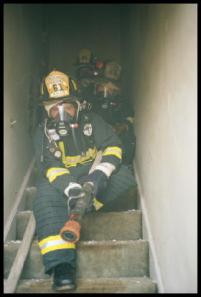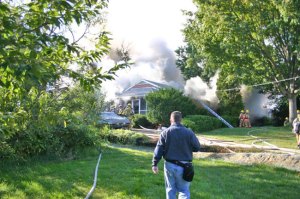Posted on October 28, 2008 by D. Mitchell
 Whatever you call it on your fire-ground; the “Charlie Sector”, “Side 3”, “the rear”, “out-back”….it does not matter to me. And, to the point of this post, it really doesn’t matter at all (this isnt a NIMS exercise). What does matter is that someone, must get to the rear.
Whatever you call it on your fire-ground; the “Charlie Sector”, “Side 3”, “the rear”, “out-back”….it does not matter to me. And, to the point of this post, it really doesn’t matter at all (this isnt a NIMS exercise). What does matter is that someone, must get to the rear.
Because we normally operate with our rigs, hose, and personnel coming from the street side of most buildings, the rear is usually not given a high priority. Often it is not addressed until much later into the fire operation. Many times however, what is…. or is not…. going on in the rear will have a major impact on operations.
Continue reading →
Filed under: Tips & Skills | Tagged: Size-Up | 4 Comments »
Posted on October 23, 2008 by capcityffyter

How many times on a structure fire do you notice that the interior stairs constantly seem to be full of firemen. This may lead to a very chaotic situation, especially if these steps need to be used for a rapid egress. While operating on a top floor cockloft fire the other morning, this situation became a reality for me.
The firefighter operating the hoseline lost control of the nozzle, the line then hit me, causing my helmet and facepiece to be knocked off. As a result my head began to burn…instinct took over and I realized I needed to exit to “get myself back together”.
I attempted to exit via the interior stairs only to realize it was blocked by spectator firemen. Luckily there was a window with a ground ladder that I could egress the fire floor on to. I was lucky, in that I was able to readjust my ppe and continue to operate without any injury. However I could have been seriously hurt.

Always remember this: YOU ARE EITHER TRAVELING UP…. OR DOWN…. THE STAIRS, NOT STANDING ON THEM AND NOT BLOCKING THEM. Next time you go to a job on an upper floor you might find yourself in a situation that you might just need those stairs.
Stay safe
Filed under: Uncategorized | 5 Comments »
Posted on October 20, 2008 by Nicholas Martin
This weekend TT Instructors Nick Martin, Tony Kelleher, Dan Shaw, Doug Mitchell, and Danny Doyle headed to the Montgomery County Fire Academy in Conshohocken, PA for another weekend of training. On Friday night we met for some drinks and good times with the guys from Erskine Lakes, NJ who traveled all the way from the northern New Jersey to attend. Due to demand for the class, we ran two separate 8-hour sessions: one on Saturday and another on Sunday. The class was entirely hands-on and we spent all day outside working.


Click for more & pics…
Continue reading →
Filed under: Company News, Engine Company | 2 Comments »
Posted on October 17, 2008 by Nicholas Martin
Of course I’m sure most of you are saying “chain”, but we all know there are vertical ventilation situations that require the axe:
- Saw failure… Out of gas, chain broke, you ripped the start-cord out, whatever. It won’t start.
- Smoky conditions. Like all engines, that saw needs a certain amount of oxygen to run. If the filter is bad or the smoke is just too nasty, the saw may stall out.
Those are a few of the obvious. Some will argue that they are faster with a good axe on certain roofs then they would ever be with a saw. In the right conditions, I can agree with that…
So lets get to the main point… When you choose an axe for roof ventilation, which are you going for?

Click more for video and to participate in our poll…
Filed under: Tips & Skills, Truck Company | Tagged: Axe, Ventilation | 4 Comments »
Posted on October 10, 2008 by capcityffyter
 Thermal Imagers (TIC’s) are prevalent in the modern day fire department. TICs have a variety of tactical uses including searching for victims, searching for hotspots, water rescue, and Hazardous Materials incidents. The most common use is searching for victims in a structure fire. It should be noted that TICs: DO NOT REPLACE PROPER SEARCH TACTICS, they are merely a tool that should be used to expand upon proper search tactics.
Thermal Imagers (TIC’s) are prevalent in the modern day fire department. TICs have a variety of tactical uses including searching for victims, searching for hotspots, water rescue, and Hazardous Materials incidents. The most common use is searching for victims in a structure fire. It should be noted that TICs: DO NOT REPLACE PROPER SEARCH TACTICS, they are merely a tool that should be used to expand upon proper search tactics.
Continue reading →
Filed under: Tips & Skills | Tagged: Search, TIC | 1 Comment »
Posted on October 9, 2008 by Danny Doyle
Think about where you are right now. Yeah, I’m talking about right now. As you sit here reading this blog. Can you describe your location in the building? If you had limited or no visibility are there  characteristics that can be identified to depict the room your in? In order to reach your location, what did you encounter? Did you go up or down stairs, pass through any doors? The questions formed above are just a few of the things that can keep you from getting in or out of trouble! Continue reading →
characteristics that can be identified to depict the room your in? In order to reach your location, what did you encounter? Did you go up or down stairs, pass through any doors? The questions formed above are just a few of the things that can keep you from getting in or out of trouble! Continue reading →
Filed under: RIT / Survival, Tips & Skills | Leave a comment »
Posted on October 6, 2008 by Nicholas Martin

Side A/B
The other day, while talking about basement checks, the idea of a “circle check” came up. This may show us hazards & conditions we would not be aware of if we just rushed in the front door… Quite bluntly – the time to do this is IMMEDIATELY. If we don’t know the whole story, we may employ inappropriate tactics, or worse, hurt/kill one of our own.
At right is a fire in Burtonsville, MD that occurred on September 20. Take a look and think about your initial size-up.
- Building use.
- Building construction.
- Building size/height.
- Fire conditions/location.
Then click below to see what this fire has to do with “circle checks” or “side-C size-ups.
Continue reading →
Filed under: Engine Company, RIT / Survival, Truck Company | 6 Comments »
Posted on October 2, 2008 by Dan Shaw

We have talked about in previous posts that what we carry is based on the space you have available, the rig you ride, and the experience you have gained from running calls. Since I ride an Engine everyday, my focus is on the simple, yet sometimes challenging, task of putting water on the fire by stretching and operating hoselines.
Continue reading →
Filed under: Tips & Skills, Uncategorized | 1 Comment »
Posted on October 2, 2008 by Nicholas Martin
 Basement fires are the most dangerous fire you can go to. Or at least its one of the most dangerous…. Throughout my career, some of the most hellacious fires I have been to started in the basement. Unfortunately, a few of these have involved near-fatal firefighter injuries.
Basement fires are the most dangerous fire you can go to. Or at least its one of the most dangerous…. Throughout my career, some of the most hellacious fires I have been to started in the basement. Unfortunately, a few of these have involved near-fatal firefighter injuries.
Two of the most common issues at basement fires are the destruction of flooring members beneath crews operating on the 1st floor and difficulty in accessing the basement. I’ll discuss these issues in an upcoming post.
There are a few reasons these fire are so hazardous:
Continue reading →
Filed under: Engine Company | Tagged: Basement Fire | 7 Comments »
Posted on October 1, 2008 by Nicholas Martin
 There isn’t a whole lot about engine company operations that matters if you can’t get water on the fire. Unfortunately most of us have heard the “more line, more line!!” yells on more than one occasion. Correctly estimating the stretch, the distance between the rig and the fire and the amount of hose needed to cover it, is an essential skill for any engine company officer. Here are a few quick tips I’ve learned over the years:
There isn’t a whole lot about engine company operations that matters if you can’t get water on the fire. Unfortunately most of us have heard the “more line, more line!!” yells on more than one occasion. Correctly estimating the stretch, the distance between the rig and the fire and the amount of hose needed to cover it, is an essential skill for any engine company officer. Here are a few quick tips I’ve learned over the years:
Continue reading →
Filed under: Engine Company, Tips & Skills | Tagged: Company Officer, Engine Company, Hoseline | 6 Comments »
 Whatever you call it on your fire-ground; the “Charlie Sector”, “Side 3”, “the rear”, “out-back”….it does not matter to me. And, to the point of this post, it really doesn’t matter at all (this isnt a NIMS exercise). What does matter is that someone, must get to the rear.
Whatever you call it on your fire-ground; the “Charlie Sector”, “Side 3”, “the rear”, “out-back”….it does not matter to me. And, to the point of this post, it really doesn’t matter at all (this isnt a NIMS exercise). What does matter is that someone, must get to the rear. 









